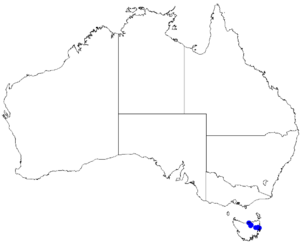Gunn's boronia facts for kids
Quick facts for kids Gunn's boronia |
|
|---|---|
 |
|
| Boronia gunnii in the Australian National Botanic Gardens | |
| Conservation status | |
| Scientific classification | |
 |
|
| Occurrence data from Australasian Virtual Herbarium |
Boronia gunnii, also known as Gunn's boronia or Cataract Gorge boronia, is a special plant. It belongs to the citrus family called Rutaceae. This plant is found only in Tasmania, Australia. It grows as an upright shrub. Its leaves are made of several smaller leaflets. The flowers are usually pink or white and have four petals.
Contents
What Gunn's Boronia Looks Like
Gunn's boronia is an upright shrub. It can grow up to about 1.2 meters (4 feet) tall. Its branches have tiny, stiff hairs. You can also see small, rounded glands on them.
The leaves of this plant are interesting. Each leaf has five, seven, or nine smaller parts called leaflets. The whole leaf can be 12 to 32 millimeters (0.5 to 1.3 inches) long. It can also be 16 to 50 millimeters (0.6 to 2 inches) wide.
The leaflet at the very end is 5 to 16 millimeters (0.2 to 0.6 inches) long. It is also 0.5 to 2.5 millimeters (0.02 to 0.1 inches) wide. The leaflets on the sides are similar but a bit longer.
The flowers are usually pink, but sometimes they are white. They grow either alone or in small groups. These groups can have up to seven flowers. They appear where the leaves meet the stem. Each group of flowers grows on a short stalk. This stalk is about 1.5 to 3 millimeters (0.06 to 0.1 inches) long.
Each flower has four triangular sepals. These are small leaf-like parts at the base of the flower. They are about 1 millimeter (0.04 inches) long and wide. The four petals are narrow and egg-shaped. They are 5 to 8 millimeters (0.2 to 0.3 inches) long. They are also 1.2 to 3 millimeters (0.05 to 0.1 inches) wide. The petals have a pointed tip. The stamens, which are the parts that produce pollen, are slightly hairy. Gunn's boronia flowers from October to January.
How it Got its Name
The plant Boronia gunnii was first officially described in 1855. A scientist named Joseph Dalton Hooker wrote about it. He published his description in a book called The botany of the Antarctic voyage of H.M. Discovery ships Erebus and Terror.
The plant was found by Ronald Campbell Gunn. He collected a sample of it. This sample was found on rocks near the South Esk River in Launceston, Tasmania. The specific name gunnii honors Ronald Campbell Gunn. He was the person who collected the first sample of this plant.
Where Gunn's Boronia Lives
Gunn's boronia grows in places that sometimes flood. You can find it in rock cracks or among large rocks. It lives near several rivers in Tasmania. However, it is now thought to be gone from Cataract Gorge. This is the place where it was first discovered.
Protecting Gunn's Boronia
Gunn's boronia is listed as "vulnerable." This means it is at risk of becoming extinct. It is protected under two important laws. These are the Commonwealth Government Environment Protection and Biodiversity Conservation Act 1999 (EPBC) Act. It is also protected under the Tasmanian Government Threatened Species Protection Act 1995.
There are several things that threaten this plant.
- A disease called dieback, caused by Phytophthora cinnamomi, can harm it.
- Fires that happen at the wrong time or too often can also be a problem.
- Changes in how water flows in rivers can affect its home.
- Weeds invading its habitat also pose a risk.


